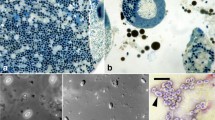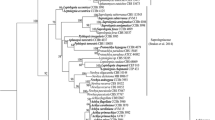Abstract
Microsporidia are widespread endoparasites of animals, including humans. They are characterized by highly modified morphological and genetic features that cause difficulties in elucidating their enigmatic origin and evolution. Recent advances, however, indicate that the Microsporidia have emerged from the Rozellomycota, forming together either the most basal lineage of the Fungi or its closer relative. The Rozellomycota comprise a huge diversity of uncultured environmental clones, with a very few known species endoparasitic of algae and water moulds, like the chytrid-like Rozella, and of free-living amoebae, like Nucleophaga and the microsporidia-like Paramicrosporidium. A possible ancestral microsporidium, Mitosporidium, has recently been described from the water flea Daphnia, since the phylogenomic reconstruction showed that it branches to the root of the microsporidian tree, while the genome analysis revealed a fungal-like nuclear genome and the persistence of a mitochondrial genome. Here we report the 18S rDNA molecular phylogeny of an additional microsporidium-like endoparasite of amoebae, which has a developmental cycle almost identical to that of Nucleophaga amoebae. Our results show that the endoparasite is closely related to N. amoebae, forming a distinct species, for which we propose the name Nucleophaga terricolae. Furthermore, the Nucleophaga lineage is recovered as sister to the Microsporidia while Mitosporidium turns out to be member of a well-supported group of environmental clones. These results raise the question about the actual ancestry of the Microsporidia within the Rozellomycota. A precise and robust phylogeny will require further comparative genomic studies of these various strains, and should also consider the primitive microsporidia, for which genetic data are still lacking, because all these organisms are essentially morphologically similar.




Similar content being viewed by others
References
Bass D, Cavalier-Smith T (2004) Phylum-specific environmental DNA analysis reveals remarkably high global biodiversity of Cercozoa (Protozoa). Int J Syst Evol Microbiol 54:2393–2404
Corradi N (2015) Microsporidia: eukaryotic intracellular parasites shaped by gene loss and horizontal gene transfers. Annu Rev Microbiol 69:167–183
Corsaro D, Michel R, Walochnik J, Müller K-D, Greub G (2010) Saccamoeba lacustris sp. nov. (Amoebozoa: Lobosea: Hartmannellidae), a new lobose amoeba, parasitised by the novel chlamydia ‘Candidatus Metachlamydia lacustris’ (Chlamydiae: Parachlamydiaceae). Eur J Protistol 46:86–95
Corsaro D, Müller K-D, Wingender J, Michel R (2013) ‘Candidatus Mesochlamydia elodeae’ (Chlamydiae: Parachlamydiaceae), a novel chlamydia parasite of free-living amoebae. Parasitol Res 112:829–838
Corsaro D, Walochnik J, Venditti D, Steinmann J, Müller K-D, Michel R (2014a) Microsporidia-like parasites of amoebae belong to the early fungal lineage Rozellomycota. Parasitol Res 113:1909–1918
Corsaro D, Walochnik J, Venditti D, Müller K-D, Hauröder B, Michel R (2014b) Rediscovery of Nucleophaga amoebae, a novel member of the Rozellomycota. Parasitol Res 113:4491–4498
Dangeard P-A (1895) Mémoire sur les parasites du noyau et du protoplasme. Le Botaniste 4:199–248
Díez B, Pedrós-Alió C, Marsh TL, Massana R (2001) Application of denaturing gradient gel electrophoresis (DGGE) to study the diversity of marine picoeukaryotic assemblages and comparison of DGGE with other molecular techniques. Appl Environ Microbiol 67:2942–2951
Franzen C (2004) Microsporidia: how can they invade other cells. Trends Parasitol 20:275–279
Grossart H-P, Wurzbacher C, James TJ, Kagami M (2016) Discovery of dark matter fungi in aquatic ecosystems demands a reappraisal of the phylogeny and ecology of zoosporic fungi. Fungal Ecol 19:28–38
Haag KL, James TY, Pombert J-F, Larsson R, Schaer TMM, Refardt D, Ebert D (2014) Evolution of a morphological novelty occurred before genome compaction in a lineage of extreme parasites. Proc Natl Acad Sci U S A 111:15480–15485
Hall TA (1999) BioEdit: a user-friendly biological sequence alignment editor and analysis program for Windows 95/98/NT. Nucleic Acids Res Symp Ser 41:95–98
Held AA (1981) Rozella and Rozellopsis: naked endoparasitic fungi which dress-up as their hosts. Bot Rev 47:451–451
Ishida S, Nozaki D, Grossart HP, Kagami M (2015) Novel basal, fungal lineages from freshwater phytoplankton and lake samples. Environ Microbiol Rep 7:435–441
James TY, Letcher PM, Longcore JE, Mozley-Standridge SE, Porter D, Powell MJ, Griffith GW, Vilgalys R (2006a) A molecular phylogeny of the flagellated fungi (Chytridiomycota) and description of a new phylum (Blastocladiomycota). Mycologia 98:860–871
James TY, Kauff F, Schoch CL, Matheny PB, Hofstetter V, Cox CJ, Celio G, Gueidan C, Fraker E, Miadlikowska J, Lumbsch HT, Rauhut A, Reeb V, Arnold AE, Amtoft A, Stajich JE, Hosaka K, Sung GH, Johnson D, O’Rourke B, CrockettM BM, Curtis JM, Slot JC, Wang Z, Wilson AW, Schüssler A, Longcore JE, O’Donnell K, Mozley-Standridge S, Porter D, Letcher PM, Powell MJ, Taylor JW, White MM, Griffith GW, Davies DR, Humber RA, Morton JB, Sugiyama J, Rossman AY, Rogers JD, Pfister DH, Hewitt D, Hansen K, Hambleton S, Shoemaker RA, Kohlmeyer J, Volkmann-Kohlmeyer B, Spotts RA, Serdani M, Crous PW, Hughes KW, Matsuura K, Langer E, Langer G, Untereiner WA, Lücking R, Büdel B, Geiser DM, Aptroot A, Diederich P, Schmitt I, Schultz M, Yahr R, Hibbett DS, Lutzoni F, McLaughlin DJ, Spatafora JW, Vilgalys R (2006b) Reconstructing the early evolution of fungi using a six-gene phylogeny. Nature 443:818–822
James TY, Pelin A, Bonen L, Ahrendt S, Sain S, Corradi N, Stajich JE (2013) Shared signatures of parasitism and phylogenomics unite Cryptomycota and Microsporidia. Curr Biol 23:1548–1553
Jones MDM, Forn I, Gadelha EMJ, Bass D, Massana R, Richards TA (2011) Discovery of novel intermediate forms redefines the fungal tree of life. Nature 474:200–203
Karpov SA, Mikhailov KV, Mirzaeva GS, Mirabdullaev IM, Mamkaeva KA, Titova NN, Aleoshin VV (2013) Obligately phagotrophic aphelids turned out to branch with the earliest-diverging fungi. Protist 164:195–205
Karpov SA, Mamkaeva MA, Aleoshin VV, Nassonova E, Lilje O, Gleason FH (2014) Morphology, phylogeny, and ecology of the aphelids (Aphelidea, Opisthokonta) and proposal for the new superphylum Opisthosporidia. Front Microbiol 5:112
Larsson JIR (1988) Isometric viruslike particles in spores of two microsporidia belonging to the Thelohaniidae. J Invertebr Pathol 51:163–165
Larsson JIR (2014) The primitive microsporidia. In: Weiss LM, Becnel JJ (eds) Microsporidia: pathogens of opportunity. Wiley, Chichester, pp 605–634
Letcher PM, Lopez S, Schmieder R, Lee PA, Behnke C, Powell MJ, McBride RC (2013) Characterization of Amoeboaphelidium protococcarum, an algal parasite new to the cryptomycota isolated from an outdoor algal pond used for the production of biofuel. PLoS ONE 8, e56232
Letcher PM, Powell MJ, Lopez S, Lee PA, McBride RC (2015) A new isolate of Amoeboaphelidium protococcarum, and Amoeboaphelidium occidentale, a new species in phylum Aphelida (Opisthosporidia). Mycologia 107:522–531
Lom J, Pekkarinen M (1999) Ultrastructural observations on Loma acerinae (Jirovec, 1930) comb. nov. (Phylum Microsporidia). Acta Protozool 38:61–74
López-García P, Rodriguez-Valera F, Pedrós-Alió C, Moreira D (2001) Unexpected diversity of small eukaryotes in deep-sea Antarctic plankton. Nature 409:603–607
Medlin LH, Elwood J, Stickel S, Sogin ML (1988) The characterization of enzymatically amplified eukaryotic 16S-like rRNA-coding regions. Gene 71:491–500
Michel R, Hauröder B, Zöller L (2009a) Isolation of the amoeba Thecamoeba quadrilineata harbouring intranuclear spore forming endoparasites considered as fungus-like organisms. Acta Protozool 48:41–49
Michel R, Müller K-D, Hauröder B (2009b) A novel microsporidian endoparasite replicating within the nucleus of Saccamoeba limax isolated from a pond. Endocytobios Cell Res 19:120–126
Michel R, Müller K-D, Schmid EN, Theegarten D, Hauröder B, Corsaro D (2012) Isolation of Thecamoeba terricola from bark of Platanus occidentalis harbouring spore-forming eukaryotic endoparasites with intranuclear development. Endocytobios Cell Res 22:37–42
Page FC (1988) A new key to freshwater and soil Gymnamoebae. Freshwater Biological Association, Ambleside, Cumbria, pp 66–72
Parisot N, Pelin A, Gasc C, Polonais V, Belkorchia A, Panek J, El Alaoui H, Biron DG, Brasset E, Vaury C, Peyret P, Corradi N, Peyretaillade E, Lerat E (2014) Microsporidian genomes harbor a diverse array of transposable elements that demonstrate an ancestry of horizontal exchange with Metazoans. Genome Biol Evol 6:2289–2300
Powell MJ (1984) Fine structure of the unwalled thallus of Rozella polyphagi in its host Polyphagus euglenae. Mycologia 76:1039–1048
Radek R, Kariton M, Dabert J, Alberti G (2015) Ultrastructural characterization of Acarispora falculifera n. gen., n. sp., a new microsporidium (Opisthokonta: Chytridiopsida) from the feather mite Falculifer rostratus (Astigmata: Pterolichoidea). Acta Parasitol 60:200–210
Rotari YM, Paskerova GG, Sokolova YY (2015) Diversity of metchnikovellids (Metchnikovellidae, Rudimicrosporea), hyperparasites of bristle worms (Anellida, Polychaeta) from the White Sea. Protistology 9:53–62
Sekimoto S, Rochon D, Long JE, Dee JM, Berbee ML (2011) A multigene phylogeny of Olpidium and its implications for early fungal evolution. BMC Evol Biol 11:331
Sokolova YY, Paskerova GG, Rotari YM, Nassonova ES, Smirnov AV (2014) Description of Metchnikovella spiralis sp. n. (Microsporidia: Metchnikovellidae), with notes on the ultrastructure of metchnikovellids. Parasitology 141:1108–1122
Sparrow FK Jr (1960) Aquatic Phycomycetes, 2nd edn. The University of Michigan Press, Ann Arbor
Sprague V (1977) Classification and phylogeny of the microsporidia. In: Bulla LA, Cheng TC (eds) Comparative pathobiology, vol 2, Systematics of the Microsporidia. Plenum Press, New York, pp 1–30
Vávra J, Lukeš J (2013) Microsporidia and ‘The Art of Living Together’. In: Rollinson D (ed) Advances in Parasitology, Academic Press, vol. 82, chap. 4, pp 253–320
Vávra J, Larsson JIR, Baker MD (1997) Light and electron microscopic cytology of Trichotuzetia guttata gen. et. sp. n. (Microspora, Tuzetiidae), a microsporidian parasite of Cyclops vicinus Uljanin, 1875 (Crustacea, Copepoda). Arch Protistenkd 147:293–306
Wylezich C, Jürgens K (2011) Protist diversity in suboxic and sulfidic waters of the Black Sea. Environ Microbiol 13:2939–2956
Wylezich C, Meisterfeld R, Meisterfeld S, Schlegel M (2002) Phylogenetic analyses of small subunit ribosomal RNA coding regions reveal a monophyletic lineage of euglyphid testate amoebae (order Euglyphida). J Eukaryot Microbiol 49:108–118
Wylezich C, Karpov SA, Mylnikov AP, Anderson R, Jürgens K (2012) Ecologically relevant choanoflagellates collected from hypoxic water masses of the Baltic Sea have untypical mitochondrial cristae. BMC Microbiol 12:271
Yajima Y, Inaba S, Degawa Y, Hoshino T, Kondo N (2013) Ultrastructure of cyst-like fungal bodies in myxomycete fruiting bodies. Karstenia 53:55–65
Author information
Authors and Affiliations
Corresponding author
Rights and permissions
About this article
Cite this article
Corsaro, D., Michel, R., Walochnik, J. et al. Molecular identification of Nucleophaga terricolae sp. nov. (Rozellomycota), and new insights on the origin of the Microsporidia. Parasitol Res 115, 3003–3011 (2016). https://doi.org/10.1007/s00436-016-5055-9
Received:
Accepted:
Published:
Issue Date:
DOI: https://doi.org/10.1007/s00436-016-5055-9




